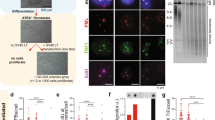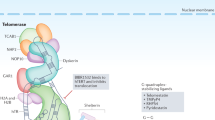Abstract
Although telomere instability is observed in human tumors and is associated with the development of cancers in mice, it has yet to be established that it can contribute to the malignant transformation of human cells. We show here that in checkpoint-compromised telomerase-positive human fibroblasts an episode of TRF2 inhibition promotes heritable changes that increase the ability to grow in soft agar, but not tumor growth in nude mice. This transforming activity is associated to a burst of telomere instability but is independent of an altered control of telomere length. Moreover, it cannot be recapitulated by an increase in chromosome breaks induced by an exposure to γ-radiations. Since it can be revealed in the context of telomerase-proficient human cells, telomere dysfunction might contribute to cancer progression even at late stages of the oncogenesis process, after the telomerase reactivation step.
This is a preview of subscription content, access via your institution
Access options
Subscribe to this journal
Receive 50 print issues and online access
$259.00 per year
only $5.18 per issue
Buy this article
- Purchase on Springer Link
- Instant access to full article PDF
Prices may be subject to local taxes which are calculated during checkout



Similar content being viewed by others
References
Ancelin K, Brunori M, Bauwens S, Koering CE, Brun C, Ricoul M et al. (2002). Mol Cell Biol 22: 3474–3487.
Artandi SE, Alson S, Tietze MK, Sharpless NE, Ye S, Greenberg RA et al. (2002). Proc Natl Acad Sci USA 99: 8191–8196.
Artandi SE, Chang S, Lee SL, Alson S, Gottlieb GJ, Chin L et al. (2000). Nature 406: 641–645.
Artandi SE, DePinho RA . (2000). Curr Opin Genet Dev 10: 39–46.
Barcellos-Hoff MH, Ravani SA . (2000). Cancer Res 60: 1254–1260.
Baur JA, Zou Y, Shay JW, Wright WE . (2001). Science 292: 2075–2077.
Bilaud T, Brun C, Ancelin K, Koering CE, Laroche T, Gilson E . (1997). Nature Genet 17: 236–239.
Bodnar AG, Ouellette M, Frolkis M, Holt SE, Chiu CP, Morin GB et al. (1998). Science 279: 349–352.
Bradshaw PS, Stavropoulos DJ, Meyn MS . (2005). Nat Genet 37: 193–197.
Callen E, Surralles J . (2004). Mutat Res 567: 85–104.
Chin K, de Solorzano CO, Knowles D, Jones A, Chou W, Rodriguez EG et al. (2004). Nat Genet 36: 984–988.
Chin L, Artandi SE, Shen Q, Tam A, Lee SL, Gottlieb GJ et al. (1999). Cell 97: 527–538.
Colgin L, Reddel R . (2004). Curr Biol 14: R901–R902.
Counter CM, Avilion AA, Le Feuvre CE, Stewart NG, Greider CW, Harley CB et al. (1992). EMBO J 11: 1921–1929.
Denko NC, Giaccia AJ, Stringer JR, Stambrook PJ . (1994). Proc Natl Acad Sci USA 91: 5124–5128.
Elenbaas B, Spirio L, Koerner F, Fleming MD, Zimonjic DB, Donaher JL et al. (2001). Genes Dev 15: 50–65.
Ferreira MG, Cooper JP . (2001). Mol Cell 7: 55–63.
Feuer G, Stewart SA, Baird SM, Lee F, Feuer R, Chen IS . (1995). J Virol 69: 1328–1333.
Gisselsson D, Jonson T, Petersen A, Strombeck B, Dal Cin P, Hoglund M et al. (2001). Proc Natl Acad Sci USA 98: 12683–12688.
Gonzalez-Suarez E, Samper E, Flores JM, Blasco MA . (2000). Nat Genet 26: 114–117.
Gonzalez-Suarez E, Samper E, Ramirez A, Flores JM, Martin-Caballero J, Jorcano JL et al. (2001). EMBO J 20: 2619–2630.
Greenberg RA, Chin L, Femino A, Lee KH, Gottlieb GJ, Singer RH et al. (1999). Cell 97: 515–525.
Greider CW, Blakburn EH . (1985). Cell 43: 405–413.
Hahn WC, Counter CM, Lundberg AS, Beijersbergen RL, Brooks MW, Weinberg RA . (1999a). Nature 400: 464–468.
Hahn WC, Dessain SK, Brooks MW, King JE, Elenbaas B, Sabatini DM et al. (2002). Mol Cell Biol 22: 2111–2123.
Hahn WC, Stewart SA, Brooks MW, York SG, Eaton E, Kurachi A et al. (1999b). Nat Med 5: 1164–1170.
Hamad NM, Elconin JH, Karnoub AE, Bai W, Rich JN, Abraham RT et al. (2002). Genes Dev 16: 2045–2057.
Karlseder J, Broccoli D, Dai Y, Hardy S, de Lange T . (1999). Science 283: 1321–1325.
Karlseder J, Hoke K, Mirzoeva OK, Bakkenist C, Kastan MB, Petrini JH et al. (2004). PLoS Biol 2: E240.
Karlseder J, Smogorzewska A, de Lange T . (2002). Science 295: 2446–2449.
Klapper W, Qian W, Schulte C, Parwaresch R . (2003). Leukemia 17: 2007–2015.
Koering CE, Pollice A, Zibella MP, Bauwens S, Puisieux A, Brunori M et al. (2002). EMBO Rep 3: 1055–1061.
Lansdorp PM, Verwoerd NP, van de Rijke FM, Dragowska V, Little MT, Dirks RW et al. (1996). Hum Mol Genet 5: 685–691.
Lechel A, Satyanarayana A, Ju Z, Plentz RR, Schaetzlein S, Rudolph C et al. (2005). EMBO Rep 6: 275–281.
Lee AC, Fenster BE, Ito H, Takeda K, Bae NS, Hirai T et al. (1999). J Biol Chem 274: 7936–7940.
Lin SY, Elledge SJ . (2003). Cell 113: 881–889.
Marcand S, Brevet V, Gilson E . (1999). EMBO J 18: 3509–3519.
Marcand S, Gilson E, Shore D . (1997). Science 275: 986–990.
Masutomi K, Yu EY, Khurts S, Ben-Porath I, Currier JL, Metz GB et al. (2003). Cell 114: 241–253.
McEachern MJ, Krauskopf A, Blackburn EH . (2000). Annu Rev Genet 34: 331–358.
Miyachi K, Fujita M, Tanaka N, Sasaki K, Sunagawa M . (2002). J Exp Clin Cancer Res 21: 269–275.
Morgenstern JP, Land H . (1990). Nucleic Acids Res 18: 3587–3596.
Nakanishi K, Kawai T, Kumaki F, Hiroi S, Mukai M, Ikeda E et al. (2003). Clin Cancer Res 9: 1105–1111.
Oh BK, Kim YJ, Park C, Park YN . (2005). Am J Pathol 166: 73–80.
O’Sullivan JN, Bronner MP, Brentnall TA, Finley JC, Shen WT, Emerson S et al. (2002). Nat Genet 32: 280–284.
Rangarajan A, Hong SJ, Gifford A, Weinberg RA . (2004). Cancer Cell 6: 171–183.
Rudolph KL, Millard M, Bosenberg MW, DePinho RA . (2001). Nat Genet 28: 155–159.
Shay JW . (1997). J Cell Physiol 173: 266–270.
Smogorzewska A, de Lange T . (2002). EMBO J 21: 4338–4348.
Smogorzewska A, Karlseder J, Holtgreve-Grez H, Jauch A, de Lange T . (2002). Curr Biol 12: 1635–1644.
Smogorzewska A, van Steensel B, Bianchi A, Oelmann S, Schaefer MR, Schnapp G et al. (2000). Mol Cell Biol 20: 1659–1668.
Teixeira MT, Arneric M, Sperisen P, Lingner J . (2004). Cell 117: 323–335.
van Steensel B, Smogorzewska A, de Lange T . (1998). Cell 92: 401–413.
Wang RC, Smogorzewska A, de Lange T . (2004). Cell 119: 355–368.
Woo RA, Poon RY . (2004). Genes Dev 18: 1317–1330.
Yamada K, Yagihashi A, Yamada M, Asanuma K, Moriai R, Kobayashi D et al. (2002a). Anticancer Res 22: 1315–1320.
Yamada M, Tsuji N, Nakamura M, Moriai R, Kobayashi D, Yagihashi A et al. (2002b). Anticancer Res 22: 3303–3307.
Zhang A, Wang J, Zheng B, Fang X, Angstrom T, Liu C et al. (2004). Oncogene 23: 7441–7447.
Zimonjic D, Brooks MW, Popescu N, Weinberg RA, Hahn WC . (2001). Cancer Res 61: 8838–8844.
Acknowledgements
We thank T de Lange, R Weinberg, S Lowe, J Shay, and R Iggo for the gifting various plasmids, vectors and cell lines. The work in EG laboratory was supported by La Ligue Nationale contre le Cancer. MB was supported by EC contract TELOSENS FIGH 2002-00217 and SB by a postdoctoral fellowship from Centre Léon Bérard (Lyon). The work in AP laboratory was supported by le Comité de l’Ain de la Ligue contre le Cancer. The work in LS laboratory was supported by EC contract TELOSENS FIGH 2002-00217. LS is grateful to S Bruniquet for her skillful technical assistance.
Author information
Authors and Affiliations
Corresponding author
Additional information
Supplementary Information accompanies the paper on Oncogene website (http://www.nature.com/onc).
Rights and permissions
About this article
Cite this article
Brunori, M., Mathieu, N., Ricoul, M. et al. TRF2 inhibition promotes anchorage-independent growth of telomerase-positive human fibroblasts. Oncogene 25, 990–997 (2006). https://doi.org/10.1038/sj.onc.1209135
Received:
Revised:
Accepted:
Published:
Issue Date:
DOI: https://doi.org/10.1038/sj.onc.1209135
Keywords
This article is cited by
-
DNA damage and the balance between survival and death in cancer biology
Nature Reviews Cancer (2016)
-
PARP1 is activated at telomeres upon G4 stabilization: possible target for telomere-based therapy
Oncogene (2010)
-
Platination of telomeric DNA by cisplatin disrupts recognition by TRF2 and TRF1
JBIC Journal of Biological Inorganic Chemistry (2010)
-
A topological mechanism for TRF2-enhanced strand invasion
Nature Structural & Molecular Biology (2007)



